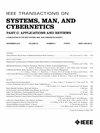Fusion of hard and soft computing techniques in indirect, online tool wear monitoring
IEEE Transactions on Systems Man and Cybernetics Part C-Applications and Re
Pub Date : 2002-05-01
DOI:10.1109/TSMCC.2002.801347
引用次数: 21
Abstract
Indirect, online tool wear monitoring is one of the most difficult tasks in the context of process monitoring for metal-cutting machining processes. Based on a continuous acquisition of certain process parameters (signals such as cutting forces or acoustic emission) with multi-sensor systems, it is possible to estimate or to classify certain wear parameters. However, despite of intensive scientific research during the past decades, the development of reliable and flexible tool wear monitoring systems is an ongoing attempt. This article introduces a new, hybrid technique for tool wear monitoring in turning which fuses a physical process model (hard computing) with a neural network model (soft computing). The physical model describes the influence of cutting conditions (such as tool geometry or work material) on measured force signals and it is used to normalize these force signals. The neural model establishes a relationship between the normalized force signals and the wear state of the tool. The advantages of this approach are demonstrated by means of experimental results. Moreover, it is shown that the consideration of process parameters, cutting conditions, and wear in one model (either physical or neural) is extremely difficult and that existing hybrid approaches are not adequate. The ideas presented in this article can be transferred to many other process monitoring tasks.间接在线刀具磨损监测中硬、软计算技术的融合
间接的、在线的刀具磨损监测是金属切削加工过程监测中最困难的任务之一。基于多传感器系统对某些工艺参数(如切削力或声发射信号)的连续采集,可以估计或分类某些磨损参数。然而,尽管在过去的几十年里进行了大量的科学研究,但开发可靠、灵活的刀具磨损监测系统仍是一个持续的尝试。本文介绍了一种新的车削刀具磨损监测混合技术,它融合了物理过程模型(硬计算)和神经网络模型(软计算)。物理模型描述了切削条件(如刀具几何形状或工作材料)对测量力信号的影响,并用于将这些力信号归一化。神经网络模型建立了归一化力信号与刀具磨损状态之间的关系。实验结果证明了该方法的优越性。此外,研究表明,在一个模型(物理或神经)中考虑工艺参数、切削条件和磨损是非常困难的,现有的混合方法是不够的。本文中介绍的思想可以转移到许多其他流程监视任务中。
本文章由计算机程序翻译,如有差异,请以英文原文为准。
求助全文
约1分钟内获得全文
求助全文
来源期刊
自引率
0.00%
发文量
1
审稿时长
3 months

 求助内容:
求助内容: 应助结果提醒方式:
应助结果提醒方式:


